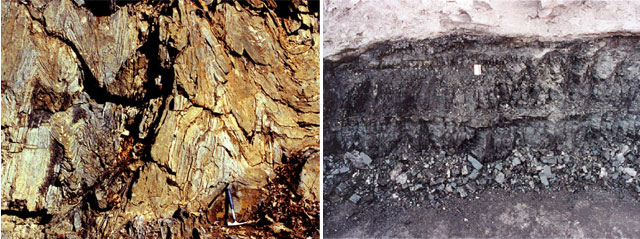
Plate Tectonics History of Virginia (Part 6)
250 Million Years Ago

• The continents of ancient North America and Africa collided as the Iapetus Ocean closed and the supercontinent of Pangaea formed. This collision ended the Wilson Cycle that began with the rifting of Rodinia.
• The continent-continent collision caused major mountain building, intrusions and metamorphism in the Blue Ridge and Piedmont, and deposition of conglomerate, sandstone, and shale in western Virginia. Extensive Appalachian Plateaus coal beds formed in swamps along the edges of the mountains.

Folding as seen in the Valley and Ridge (left) is evidence of the mountain-building that occurred during the continent collision that formed Pangaea. Sedimentary rocks such as coal (right) in the Appalachian Plateaus are evidence of the erosion of the mountains and deposition of sediment in the adjacent lowlands. (Photographs by Stan Johnson)
Structures in the Valley and Ridge, like these anticlines and synclines (left), formed during the major mountain-building event 250 million years ago. Coal in the Appalachian Plateaus (right) was also formed at the time. In the Piedmont and Blue Ridge, metamorphism and igneous intrusions affected the existing rock.
• The collision with Africa formed the "Ancestral Appalachian Mountains". Erosion has since destroyed nearly all of the original mountains. Although the mountains of 250 million years ago are gone, evidence for their existence is found throughout the Valley and Ridge, Blue Ridge, and Piedmont. Structures such as folds and faults, and metamorphic and igneous rocks that were once inside the mountains are now exposed by erosion. Geologists estimate that the Ancestral Applachians would have been far larger than the modern Appalachians we see today.